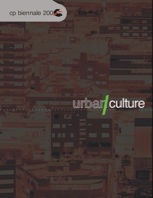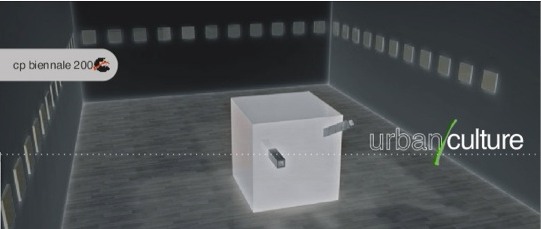| |
CP BIENNALE 2005 : Urban/Culture
 The second CP Biennale with the theme "Urban/Culture" was be held at the Bank Indonesia Museum in Kota, Jakarta from September 5, 2005 to October 5, 2005. The second CP Biennale has been designed to commemorate the 60th anniversary of the Republic of Indonesia and the 50th anniversary of the Asia-Africa Conference. The large exhibition, held every two years, will be participated in by artists from Indonesia and several foreign countries.
The second CP Biennale with the theme "Urban/Culture" was be held at the Bank Indonesia Museum in Kota, Jakarta from September 5, 2005 to October 5, 2005. The second CP Biennale has been designed to commemorate the 60th anniversary of the Republic of Indonesia and the 50th anniversary of the Asia-Africa Conference. The large exhibition, held every two years, will be participated in by artists from Indonesia and several foreign countries.
The first CP Biennale, with the theme "Interpelation", which was also taken part in by both Indonesian and foreign artists, was held in September 2003 at the National Gallery in Jakarta. The CP Biennale 2003 received response not only from the local mass media and critics, but also by art journals and other media from outside Indonesia. The journal, Asian Artnews, which is published in Hongkong, featured the exhibition in its main report of seven pages. The influential American newspaper, The New York Times, which is published in New York, printed commentary titled "A Biennale that puts Indonesia on The Map".
The curation of CP Biennale II, 2005 is meant to provide a clearer look at the social function of art, particularly in Indonesia. The Theme Urban/Culturesets forth a variety of issues: development and progress, social problems, economics and politics, as well as the matter of history. A seminar with the theme "Urban Reflection", which will be held on September 6, during the CP Biennale II, 2005, will deal specifically with the various dimensions of the problems facing urban communities.

Theme of CP Biennale II, 2005
In the development of Indonesia art, a major tendency to explore the issues existing in society has been noted. If observed carefully, the majority of the social issues dealt with are related to politics, social injustice, and the impact of globalization in major cities. Recently, a large number of exhibitions have featured this theme.
The problems of people living in urban areas in Indonesia are the problems of people living in big cities worldwide. Because of this, in the past ten years, the theme, Urban, has been featured in a number of international exhibitions. In the developing nations of Asia and Africa, the problems of cities and their populations take on specific forms that make the cities of developing countries seem chaotic. Indonesia is no exception.
Urban communities or the people, who live in big cities, are also known as civil society. In Indonesia, civil society was formed at the end of the 19th century with the development of cities during the colonial period. The indigenous component of this civil society played a major role in the development of the concept of the state of Indonesia and of independence as well. These people came to see independence as existing among their civil rights.
The commitment of civil society before independence was not limited to the struggle for civil rights. The people also struggled for the rights of those who were poor and marginalized. Within the climate of independence, this commitment did not flourish, nor did it continue. Development and modernization proceeded in the cities, as if the cities were the only places that were independent. Development in all sectors focused on the cities and resulted in the expansion of urban areas into mega cities.
There then occurred a massive urban migration because only the cities could offer progress, welfare, improved economic life, and mechanisms for achieving aspirations. So the cities became overpopulated. The poverty expanding through the cities is a sign of the shift of poverty from the underdeveloped areas outside urban centers in Indonesia.
Venue and Presentation
The Bank Indonesia Museum has been selected as the site of this exhibition with the theme of Urban/Culture. The Bank Indonesia Museum building is a Dutch colonial structure (construction was begun in1828), which has long stood witness to the development of cities in Indonesia that emerged as signs of the development of an urban society in Indonesia at the end of the 19th century.
In connection with the selection of the Bank Indonesia Museum building as the site for the CP Biennale II, 2005, CP Foundation has cooperated with Bank Indonesia as facilitator and provider of exhibition space.
The CP Biennale II, 2005 has been funded collectively by the CP Foundation and international institutions. Besides funding from CP Foundation and UBS, as a consistent donator to CP Foundation, funding has also come from international institutions, which fund international exhibitions that are not commercial in nature. Among these donators are Prince Claus Fund of the Netherlands, Asian Cultural Council Rockefeller Foundation, New York, The Japan Foundation, Tokyo and Goethe Institute. Other institutions, such as the National Art Council, Singapore and Erasmus Huis, have funded the participation of artists and speakers at the seminar who are coming from their own countries for the event.
Presentation Team
Management Team
Djie Tjianan, Production Director
Naning B. Sugeng, Production Manager
Febe Wirjadi, Finances
Pramudyarto, Coordinator for Preparation of the BI Exhibition Space
Widjang Ariwibowo, Facilitator for Preparation of the BI Exhibition Space
F. Rully, Implementer for Preparation of the BI Exhibition Space
Tridjata, Public Program Coordinator
Carline Mayreday, Media Relations
Curation Team
Jim Supangkat, Curator | Essay
Asmudjo Jono Irianto, Co-curator | Essay
Rizki Zaelani, Co-curator | Essay
Marco Kusumawidjaya Co-curator | Essay
Shin Yi Yang, Guest Curator from Taiwan | Essay
Rani Ambyo, Seminar Coordinator/Organizer
Arief Ash Shiddiq, Seminar Organizer
Oneng Aneu, Assistant Curator
Oscar Motulloh, Contributor
Suwarno Wisetrotomo, Contributor
Participants of CP Biennale II 2005
Taking into consideration the breadth and depth of the issues facing urban society, and the fact that these issues exist in all sectors, the curation team of CP Biennale II 2005 decided to invite not only painters and artists, but also architects, photographers, graphic artists and cartoonists. The works displayed have also not been created by only one individual architect or artists. Many of the works being shown at CP Biennale II 2005 are collaborative and created together, some of them in the form of projects.
There are 70 participants total, 18 of which are from abroad. See their works at the Featured Works section in this site.
Seminar: Urban Reflection, September 6, 2005
Speakers
Burhanuddin Abdullah, Governor of Bank Indonesia
Fauzi Bowo, Deputi Governor of DKI Jakarta
Jim Supangkat, Chief Curator of CP Biennale II | Essay
Marco Kusumawijaya, Co-Curator | Essay
Shin Yi Yang, Co-Curator | Essay
Timothy O'Leary, Department of Philosophy, University of Hong Kong | Essay
Nono Anwar Makarim
Mahatmanta
Undi Gunawan
Bagus Takwin
Peter Nas
Ahmad Tardiana
Doni Gahral Adian
|











 The second CP Biennale with the theme "Urban/Culture" was be held at the Bank Indonesia Museum in Kota, Jakarta from September 5, 2005 to October 5, 2005. The second CP Biennale has been designed to commemorate the 60th anniversary of the Republic of Indonesia and the 50th anniversary of the Asia-Africa Conference. The large exhibition, held every two years, will be participated in by artists from Indonesia and several foreign countries.
The second CP Biennale with the theme "Urban/Culture" was be held at the Bank Indonesia Museum in Kota, Jakarta from September 5, 2005 to October 5, 2005. The second CP Biennale has been designed to commemorate the 60th anniversary of the Republic of Indonesia and the 50th anniversary of the Asia-Africa Conference. The large exhibition, held every two years, will be participated in by artists from Indonesia and several foreign countries. 
